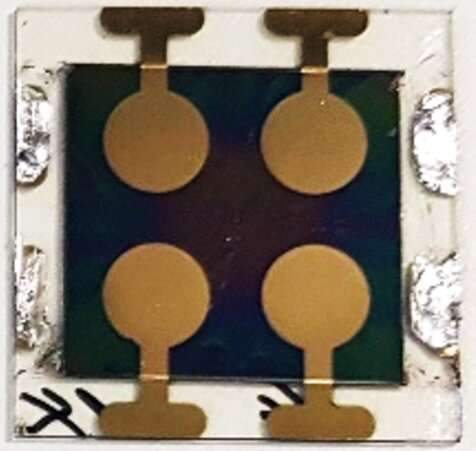This article has been reviewed according to Science X's editorial process and policies. Editors have highlighted the following attributes while ensuring the content's credibility:
fact-checked
peer-reviewed publication
proofread
A printable multi-energy X-ray detector with high sensitivity

A step-change in the field of imaging applications could be on the horizon after Exciton Science researchers demonstrated a route to multi-energy X-ray detection with significantly enhanced flexibility and sensitivity.
Developed by a team at Monash University, the technology is based on solution-processed, printable diodes made using perovskite thin films, a component more typically associated with next-generation solar energy devices.
The results of the work have been published in Advanced Materials.
Dr. Babar Shabbir, a Senior Exciton Science Research Fellow and the first author on the paper, said, "These perovskite-based detectors can provide rapid response times and offer high sensitivities to enable real-time detection and imaging for complex purposes, including disease diagnoses, detection of explosives and identifying food contamination."
The majority of X-ray detectors operate in one of two different energy levels—hard or soft. Hard X-rays are used to penetrate dense materials like bone or rock, while soft X-rays are required for safely imaging living matter such as tissue and cells.
Typical single-energy detection takes place in the hard X-ray region of between 10 and 100s of kiloelectron volts (KeV). Detection in the soft window, meanwhile, may require energy levels below 1 KeV.
Sometimes, an X-ray detector must be able to operate across both energy levels. For example, when searching for tumors within breast tissue.
Existing multi-energy X-ray detectors are made using silicon and selenium, and although they can operate in both regions, they are limited in their energy sensitivity and spatial resolution.
A promising and potentially far more effective and versatile alternative has emerged in the form of metal halide perovskites.
Named for their crystal structure, perovskite materials are inexpensive to create and can effectively manage the intensity of an X-ray beam as it passes through matter, a process known as X-ray attenuation.
Importantly, when the perovskite is fabricated within a diode device, the X-ray attenuation process induces the formation of charges that can be effectively collected to provide a signature of the X-ray energy and its intensity.
In this new work, it has been shown that perovskite-based multi-energy X-ray detectors can operate in a broad energy range from 0.1 KeV into the 10s of KeV, significantly wider than existing conventional multi-energy X-ray detectors.
Previous demonstrations of perovskite-based devices were limited to hard X-ray detection, and at a small scale ranging from millimeters to centimeters.
Not only is this the first time that perovskites have been used for soft X-ray detection, the new approach is also suitable for scaling up to the large areas necessary for commercial use.
And because the perovskite detectors will be made as a thin film, they could be combined with flexible substrates to unlock a new range of device shapes and sizes.
Professor Jacek Jasieniak of Monash University, an Exciton Science Chief Investigator and the senior author on the paper, said, "This work showcases that there's a natural extension of perovskites into printed X-ray detectors.
"They should be cheaper to make, and could also involve modified film form factors, where you need inherent flexibility.
"It opens up the field to a whole new set of questions about how to use these types of devices."
More information: Babar Shabbir et al, Printable Perovskite Diodes for Broad‐Spectrum Multienergy X‐Ray Detection, Advanced Materials (2023). DOI: 10.1002/adma.202210068
Journal information: Advanced Materials
Provided by ARC Centre of Excellence in Exciton Science




















